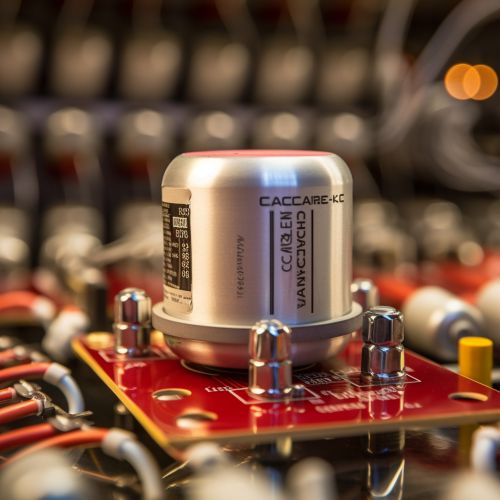Capacitor
Introduction
A capacitor is a two-terminal, passive electrical component that stores energy in an electric field. The effect of a capacitor is known as capacitance. While some capacitance exists between any two electrical conductors in proximity in a circuit, a capacitor is specifically designed to provide and enhance this effect for a variety of practical applications by consideration of size, shape, and positioning of closely spaced conductors.


History
The earliest form of capacitors was known as the Leyden jar, invented in the city of Leiden in 1745. The Leyden jar was the first means of storing an electric charge which then could be discharged at the experimenter's will. The Leyden jar was a simple device, consisting of a glass jar, partially filled with water, and sealed with a cork. A metal rod that passed through the cork and extended into the water was connected to a prime conductor, a device used to accumulate and hold static electricity.
Construction
A capacitor consists of two conductive plates separated by an insulating material, or dielectric. The plates accumulate electric charge when connected to a power source. One plate accumulates positive charge, the other negative. The dielectric acts to increase the capacitor's charge capacity. Materials commonly used as dielectrics include glass, ceramic, plastic film, air, vacuum, paper, mica, and oxide layers. Capacitors are widely used in electronic circuits for blocking direct current while allowing alternating current to pass, in filter networks, for energy storage, and for tuning resonant circuits.
Types of Capacitors
Capacitors come in a variety of shapes and sizes, all of which depend on the specific application, but they all contain at least two electrical conductors separated by a dielectric. The conductors can be thin films of metal, aluminum foil or disks, etc. The nonconducting dielectric acts to increase the capacitor's charge capacity. Materials commonly used as dielectrics include glass, ceramic, plastic film, air, vacuum, paper, mica, and oxide layers.
Ceramic Capacitors
Ceramic capacitors are the most commonly used capacitors in the electronics industry. They are named after the ceramic material which is used as the dielectric. A ceramic capacitor is a fixed-value capacitor where the ceramic material acts as the dielectric. It is constructed of two or more alternating layers of ceramic and a metal layer acting as the electrodes.
Electrolytic Capacitors
Electrolytic capacitors are popular because of their large capacitance-to-volume ratio. They use an electrolyte (an ionic conducting liquid) as one of the plates to achieve larger capacitance. The electrolyte can be either wet (as in a wet cell), or dry (as in a dry cell).
Film Capacitors
Film capacitors are named for the thin plastic film which serves as the dielectric. They are made by taking a thin strip of plastic film, coating it with a thin layer of metal, and rolling it up into a cylinder.
Super Capacitors
Super capacitors also known as ultra-capacitors, are a type of capacitor that can store a large amount of energy, typically ten to a hundred times that of an electrolytic capacitor. They can accept and deliver charge much faster than batteries, and tolerate many more charge and discharge cycles than rechargeable batteries.
Capacitance
Capacitance is the ratio of the change in an electric charge in a system to the corresponding change in its electric potential. There are two closely related notions of capacitance: self capacitance and mutual capacitance. Any object that can be electrically charged exhibits self capacitance. A material with a large self capacitance holds more electric charge at a given voltage than one with low capacitance. The notion of mutual capacitance is particularly important for understanding the operations of the capacitor, one of the three fundamental electronic components (along with resistors and inductors).
Applications
Capacitors have many uses in electronic and electrical systems. They are so ubiquitous that it is rare that an electrical product does not include at least one for some purpose.
Energy Storage
The energy stored in a capacitor can be used to represent information, either in binary form, as in digital circuits, or in analog form, as in analog circuits. The energy can also be used to provide power for a circuit, or for energy storage in a more general sense, such as in power conditioning systems.
Power Conditioning
Capacitors can be used in power conditioning systems to store energy for later use. This can be useful in systems that have a demand for power that is greater than the power source's ability to provide it.
Signal Filtering
In analog filter networks, capacitors are used together with resistors and inductors to adjust the response of the system to different frequency bands.
Tuning
Capacitors are used in tuning circuits for resonant circuits. For example, in radio receivers and transmitters, a capacitor is used to tune the frequency of the resonant circuit to the frequency of the incoming radio signals.
